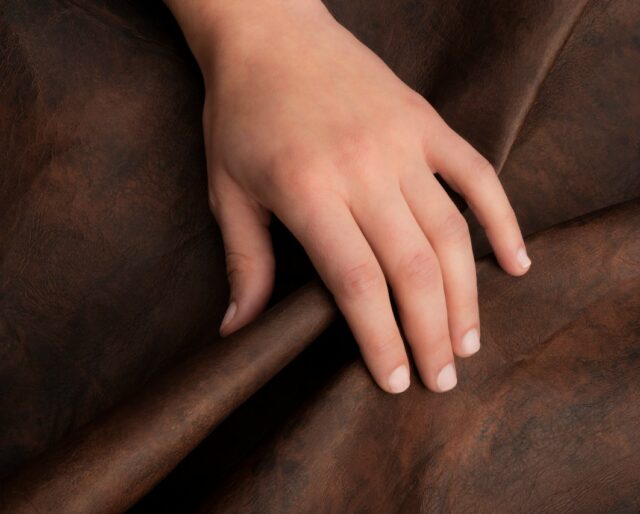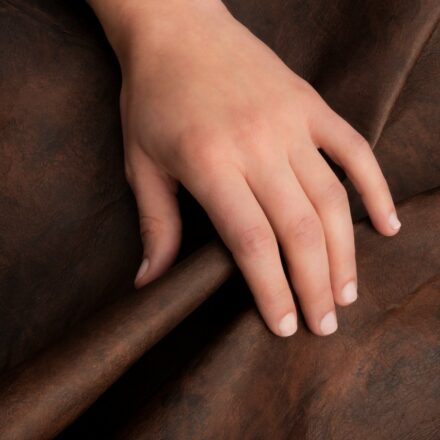By Susan Kuchinskas, contributor
Your favorite pair of blue jeans generated a lot of toxic waste on their way to you. The synthetic indigo dyeing process that’s commonly used requires toxic chemicals including formaldehyde, chromium and hydrogen cyanide that are later flushed away.
Indigo blue isn’t the only dye that’s concerning. Fabric dyeing and finishing are responsible for 17-20% of industrial water pollution, thanks to some 72 toxic chemicals these processes release into rivers, 30 of which can’t be removed.

Nor is dyeing the only source of pollution by the fashion industry. Leather tanning, the process of softening, preserving and dying hides, consumes around 105.6 billion gallons of fresh water each year, while releasing pollutants including hydrogen sulfide, sulfur dioxide, ammonia, chromium and volatile organic compounds. And, of course, livestock rearing produces 14.5% of all human-caused greenhouse gas emissions, according to UNESCO.
Unfortunately, vegan leather isn’t always the answer, as most of it’s made from plastic, which also comes from fossil fuel, emits gasses during production and isn’t biodegradable.
Fashion can be a dirty business. But perhaps not for long, if a wave of eco-conscious startups succeeds.
Cleaning up
Suzanne Lee, CEO of Biofabricate, a consultancy focused on biomaterials, says, “The fiber most used in the world is polyester. It’s fossil-fuel derived and a finite resource. People know about microplastic pollution in the ocean and in our bodies. But it’s very cheap. These manmade synthetics we’ve come to love for their performance and cheapness are very challenging to replace because of that.”
But a cohort of startups is up for the challenge. Some, such as Werewool, Spiber and Polybion, hack the genomes of bacteria to produce fiber. Huue and Colorifix engineer microbes to make sustainable, non-toxic dyes for the fashion industry.
Manmade synthetics we’ve come to love for their performance and cheapness are very challenging to replace.
—Suzanne Lee, CEO, Biofabricate
Others, like Hide Biotech and Bioleather, are processing food waste into leather alternatives. Then, there’s Sqim and Ecovative, turning mushroom mycelium into alt leather.
While some of these materials are still in the R&D stage, others are coming into the market. Bioleather is selling its Tomato Leather for $39 per square meter, with a minimum order of 100 square meters. Balenciaga’s Winter 2022 show featured a coat made from EPHEA, a material Sqim created for the fashion house.
Lee, whose company also produces the Biofabricate Summit, a conference on biomaterials, says, “2022 feels like the turning point for these innovations.”
Upcycling
As with any kind of startup, these companies need to be able to produce large quantities of material or dye to be able to meet the needs of manufacturers.
Upcycling agricultural and food waste is one approach. Hide’s material is shaped from collagen extracted from fish waste. That’s a resource of up to 65 million tons produced each year, according to the company. Hide sources its fish scraps from a company that’s certified as sustainable.

There’s much less waste with the product, since it can be made in rectangular pieces, and dye can be incorporated as the material is being made, reducing the amount of dye necessary and wasting none of it. Hide says its product’s carbon footprint is less than 10% than that of leather.
Hide CEO Yudi Ding says, “Because we’re using a waste stream, we should be able to hit cost parity with traditional leather. In order to achieve our sustainability goals, we need to provide a solution that’s scalable at a reasonable cost.” He says Hide’s initial pricing will be on par with good quality leather.
Ding says the company already has provided samples of around one yard to several fashion brands, although he can’t disclose them.
Bioleather sources tomatoes that can’t be sold as food directly from farmers, and the company is reaching out to several ketchup manufacturers to obtain the seeds and skin left over from production.
Company founder Pritesh Mistry says, “There will always be enough tomatoes.”
Fun with fungi
Mycelium, the threadlike mass that makes up the body of a multicellular fungus, has proven to be a versatile and useful base for materials. Sqim combines different fungal species and grows them on agricultural waste. The mycelium digests part of the substrate it’s grown on and binds particles in the substrate into a mass suitable for shaping into the final material.

In addition to its EPHEA leather-like material, Sqim’s MOGU brand is dedicated to mycelium-based products for architecture and interior design.
Maurizio Montalti, co-founder and chief mycelium officer, says its fungal bank now contains more than 250 strains that it can screen for potential uses. He says, “There are more than 5 million estimated species of fungus and unlimited strains, each a universe in its own. We pretend to know a lot but still have so much to discover to understand the full potential of these fungi that we are not ready to use.”
Hijacking biology
Other companies working on sustainable materials and dyes take a synthetic biology approach, engineering yeast and bacteria to produce desirable molecules in vats, similar to the way beer is brewed.
Huue started with bacteria-brewed indigo because of the ubiquity of blue denim, but it eventually aims to produce other dyes.
Says Huue CEO Michelle Zhu, “Nature already has the blueprint for how you can produce color. Specific enzymes within plants are responsible for creating the specific color molecules. The idea behind Huue is, we program microbes to mirror that process. We find and code those exact enzymes focused on creating that target color of interest.”
Scaling up
Circularity is an important component of these companies’ projects. As Sqim’s Montalti says, “Our fundamental value is using material with low value or waste and transforming it into higher-value products.”
And, instead of creating waste, whether solid or emitted, they can feed their own waste products back into their systems. For example, Sqim can add the residues from its processes into the mycelium’s growth medium.
But sustainability can’t compromise marketability if these companies want to succeed.
Says Zhu of Huue, “We’re out to create a no-compromise approach while not asking our partners and supply chains to sacrifice on affordability. There needs to be a natural ramping-up point, starting with smaller collections and then building up the supply chain over time. But it doesn’t serve the planet to be a niche solution. We’re here to create a solution that can be competitive in all dimensions.”
Lead image of flexible mycelium materials by SQIM. Photo courtesy of ©ephea™.

